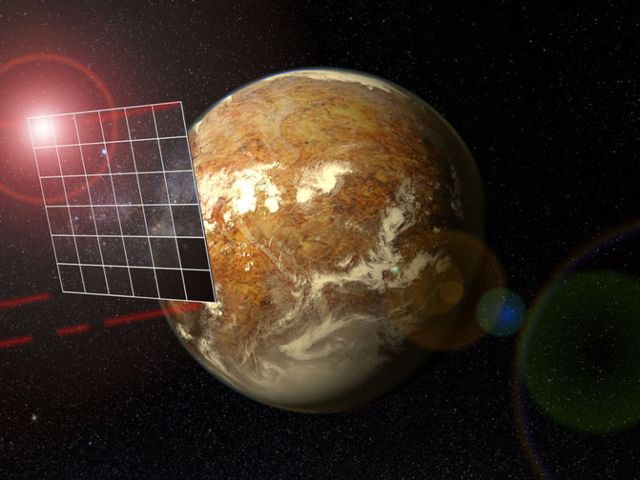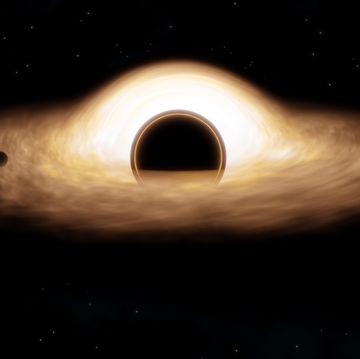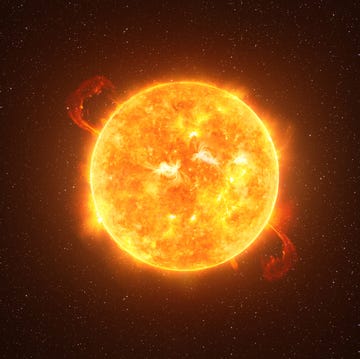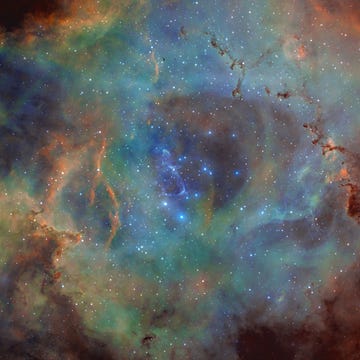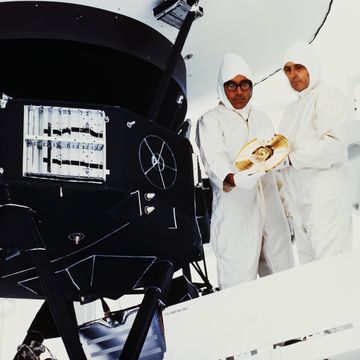The Breakthrough Starshot Initiative, announced by billionaire Yuri Milner last April with support from Stephen Hawking and Mark Zuckerberg, proposes to send a tiny spacecraft to the Alpha Centauri system, our closest neighboring stars. The craft would accelerate to around 20 percent the speed of light using a technology called photonic propulsion. Essentially, the plan is to build lasers on Earth that would blast a reflective surface, called a light sail, pushing the small probe—a computer board with a few basic electronics—up to the relativistic speeds.
On paper, all of this is achievable with current technology, and the little probe would reach its destination in 20 or 30 years. But there is a problem. Just how the heck do you slow down from 100 million mph so the spacecraft doesn't sail by Alpha Centauri too fast for any observations?
Two researchers from the Max Planck Institute for Solar System Research, René Heller and Michael Hippke, have come up with a plan—a plan to not only slow down at Alpha Centauri, but actually to visit the Earth-like planet recently discovered in the system, Proxima b.
Heller and Hippke propose redeploying the light sail once the probe reaches the three Alpha Centauri stars and using the radiation from one of the stars to slow down. Think of it this way: Many light sail projects propose using the sun's photons to push the sail, propelling the craft in the right direction. This plan would involve using the photons of the other star to push against the spacecraft's motion, slowing it down.
After enough deceleration, the probe could actually be captured by the gravity of Alpha Centauri A, one of the two main stars in the system. From there, the probe could reposition its sail to swing around Alpha Centauri A, and continue on to Proxima Centauri, the small red dwarf star in the system that hosts Proxima b in its habitable zone. With shrinking camera technology, and a bit of luck, we might actually snap a photo of this distant world.
Unfortunately, no one alive today will live to see it. Heller and Hippke were forced to reevaluate the original Breakthrough Starshot plan to make their braking system feasible. What they found is that the probe needs to travel slower in the first place, more like 4.6 percent the speed of light.
"In our nominal mission scenario, the probe would take a little less than 100 years–or about twice as long as the Voyager probes have now been traveling. And these machines from the 1970s are still operational," said Hippke in a press release.
The computer simulations they ran used a probe with a mass of less than 100 grams lashed to a 100,000-square-meter light sail, which is about the size of 14 soccer fields. The probe would receive more braking power as it approached the Alpha Centauri system. One of the most exciting things about Heller and Hippke's proposal is that the reduced speeds involved allow the light sail to be propelled by the sun, eliminating the need to build a worldwide laser system. In other words, we could launch sooner.
Of course, there are a number of major engineering obstacles to overcome. "The sail could be made of graphene, an extremely thin and light but mega-tough carbon film," Heller says. That graphene film would then have to be coated in a highly reflective material to achieve the required propulsion. The electronics and optics on the probe would also have to be minuscule, but as Heller points out, if you stripped a smartphone of all unnecessary components, "only a few grams of functional technology would remain."
There is also the problem of powering the spacecraft so it can navigate and send a signal back to Earth. Heller and Hippke propose using solar energy from the sun on launch, and from Alpha Centauri A on arrival, requiring a photovoltaic panel to be included. It's also possible that a tiny amount of uranium-235 or plutonium-239 could be used as a nuclear fuel source, but developing the necessary equiptment and still getting in under the weight restrictions would prove challenging.
Finally, engineers would have to reckon with the problem of deploying and redeploying the sail. Space is commonly referred to as a vacuum, but there are actually particles in interstellar space, mainly hydrogen, that the craft would encounter on its journey. Leaving the sail fully deployed could subject it to damaging impacts with these particles, especially at 4.6 percent the speed of light. Still, a protective coating could be used, or perhaps a system could be developed to collapse the sail into a more secure form until it reaches Alpha Centauri.
Even if we could launch tomorrow, the craft would take roughly 100 years to get to its destination and an additional 5 years just to send a signal back at the speed of light. That closeup photo of Proxima b just isn't for this generation.
"Our new mission concept could yield a high scientific return, but only the grandchildren of our grandchildren would receive it. Starshot, on the other hand, works on a timescale of decades and could be realized in one generation," says Heller. Still, "many great visions in the history of mankind had to struggle with seemingly insurmountable obstacles. We could soon be entering an era in which humans can leave their own star system to explore exoplanets using fly-by missions."
Source: Max Planck Society

Jay Bennett is the associate editor of PopularMechanics.com. He has also written for Smithsonian, Popular Science and Outside Magazine.
